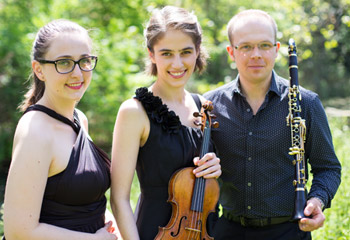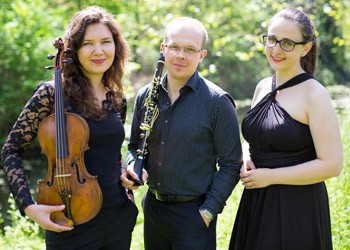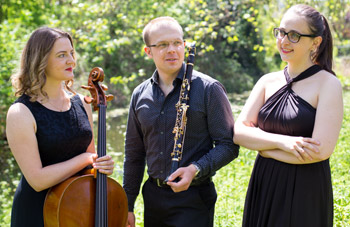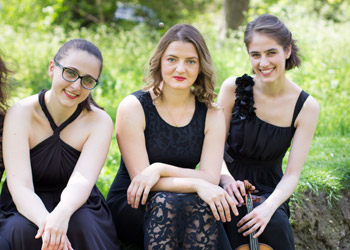Clarinet, Violin & Piano Trio

Here's how it all started, with our Clarinet/Violin/Piano Trio flex! An extremely versatile and exciting combination, the best known work for the medium is probably Hungarian master Béla Bartók's Contrasts, Sz.111. Famously written in response to a letter from violinist Joseph Szigeti, but officially commissioned by jazz clarinettist Benny Goodman and based on Hungarian and Romanian dance melodies.
The medium only really began at the start of the 20th Century, but the vastly different sonorities and varying registers of the violin and clarinet enable an amazing textural and timbral clarity not so immediate in the other clarinet trios. This provides a visually and acoustically stimulating experience.
Much of the repertoire draws from folk routes, although there is fantastic variety. From Bartok’s seminal Contrasts, Stravinsky's Suite from L'Historie du Soldat (drawing on influences from jazz and ragtime and based on the Russian folk tale 'The Runaway Soldier and the Devil') and Khachaturian's hypnotic Trio, to stunningly virtuosic modern works such as Paul Schoenfield's Trio and traditional Klezmer music, to incidental music from Milhaud and Poulenc, there’s something to suit everyone.
Clarinet, Viola & Piano Trio

Here's our Clarinet/Viola/Piano Trio flex. This medium began with Mozart and is perhaps the very first clarinet trio - certainly the best known and earliest surviving work for this combination. Mozart’s famous 'Kegelstatt' Trio, KV.498 earned its nickname from the uncorroborated rumour it was composed during an afternoon game of skittles (an old European variety of bowling) and single-handedly gave birth to a new medium.
Sharing a similar register and range, the deep, rich sounds of the viola blend with the warm and luscious sonorities of the clarinet to create a harmonious combination. Most of the repertoire embrace these qualities at their core; sometimes blending to the point where the instruments sound as one.
From Mozart’s intimate and introspective 'Kegelstatt' Trio, Schumann’s beautiful, light-hearted yet agitated 'Fairy Tales', Op.132 and Max Bruch's luscious Eight Pieces, Op.83, to more modern works such as Kalevi Aho's haunting Trio with threads of Mahlerian seriousness, back to Hungarian master György Kurtág's expressive yet sombre Hommage à Schumann and Françaix's amusingly entertaining Trio (juxtaposing his iconic lyrical and witty voices; written for the clarinet's 300th Birthday!); there is a massive breadth to the medium.
Clarinet, Cello & Piano Trio

This is our Clarinet/Cello/Piano Trio flex, perhaps the most commonly heard of the three core clarinet trios. The medium began with Beethoven, but is probably best known through the Brahms Trio in A minor, Op.114; famously written for clarinettist Richard Mühlfeld (alongside the clarinet quintet and two sonatas) a year after Brahms declared his retirement from composing!
Much like the trio with viola, the clarinet and cello share much of the same core register (excepting the lowest/highest octaves), and blend to enhance each others' mellow characteristics. Again, much of the repertoire embrace these qualities and create a rich, powerful combination.
Spanning more than two centuries, from Beethoven's youthful Trio, Op.11 and Brahms' dark and sombre Trio, Op.114 (tinged with bittersweet nostalgia), to the energetic trios from Nino Rota (prolific Italian composer, best known for his film scores) and Robert Muczynski, to Marko Tajcevic's hypnotic and rustic Seven Balkan Dances, and back to Zemlinsky, Bruch and the typically British composer John Ireland (juxtaposing lyrical/pastoral/stormy/energetic characters); the medium has fantastic variety.
Piano Trio
Violin / Cello / Piano

A chamber music staple, here is our Piano Trio flex (Violin/Cello/Piano). The Piano Trio developed out of the Baroque Trio Sonata, where a keyboard continuo part supported the violin, often with the addition of Cello playing the basso continuo line. In the mid 1800s, composers such as Mondonville and Rameau were instrumental in bringing the keyboard part to prominence and from this point, composers began to fully notate the keyboard line, instead of using figured bass which would be realised by the performer. Haydn was an important and prolific composer and developer of the medium, followed by Mozart. Throughout both these composers' output it is clear to see the development of the string parts as they take on their own independent role; by the time Beethoven was composing Piano Trios, each instrument shared equal responsibility.
By the early 19th Century the medium was very popular and the appeal has remained, leading to a huge repertoire of works spanning across this whole period to the present day. During the Romantic period, composers exploited both the improvements of the instruments themselves and the rise in the virtuosic performer to produce brilliant and highly demanding works. Many of the principal European composers wrote for this combination spanning the 19th and 20th Centuries, including Mendelssohn, Schubert, Chopin, Schumann, Dvorak, Brahms, Tchaikovsky, Rachmaninov, Faure, Ravel, Shostakovich, Enescu and many more. Many contemporary composers have continued to write successfully for the medium.
The wealth and richness of the Piano Trio repertoire allows us to programme many of the great chamber masterworks.
© 2016 Ensemble Mirage | Login
